|
|
| home > files |
| NY
AV. A section through the city and through time Martha Skinner, Doug Hecker |
||||
| The
NY AV installation is mobile yet site-specific. A trailer similar to
those for movieproduction is situated in different locations along the
trajectory of Manhattan's most diverse street, Broadway. As it unfolds
each day in a new location, the public is invited to view analytical
reconstructions of the pedestrian experience in that particular place. Three screens play an edited video documentation of Broadway at three different speeds. There is an insistent and hypnotic quality to the rendering of the films as they draw you into the activity of each block along the entire length of Broadway as we transverse Manhattan. We are invited to witness the view through the lens of the camera as it is positioned at one end of the block. Each block is represented by a mesmerizing telescoping effect of the snapshot zooming into itself until all information is exhausted, thus, setting up for the next block. The procession of the NY AV through the great nave of Manhattan with ritualistic pauses along the way seeks to generate a cross-section of the city imbued with the intimacy of the triptych. The rhythm created by the zoom feature sets up a meditative tone to the installation. The first film moves fast: 236 blocks traveled in minutes. The zoom could be understood as the search that perpetually moves us forward yet the depth of each search limited as it is interrupted by a new intersection where a new focus is sought again. The second, and slower film, moves at a speed that is perceptible as real-time. A voice narrates by calling out the street numbers as we transverse the island. We are reminded of the indiscriminating passage of time with the name of each sequentially numbered intersection; the distance of the block becomes a measure of time. The last, and third projection reveals a very slow development of the same film. Time is stretched as each motion unravels slowly. Contrary to the first projection where speed appears to override any notion of accountability; here we are indirectly reminded of the precisely choreographed motions necessary to keep the clockwork of life in the city. Beyond being an archive as well as an inhabitable instrument that captures a cinematic experience, NY AV seeks to generate an architectural drawing: a section. For architecture to evolve and find new modes of expression it must find new methods of representation. Manuel de Sola-Morales once said that "To draw is to select, to select is to interpret and to interpret is to propose". NY AV selects and interprets and the possibilities for what it may propose are endless. Speranza Octavia |
||||
 In the summer of 2001 a series of stationary audio/video takes zooming north on Manhattan was collected by walking the length of Broadway on the island during the period of a week. Four years later, a container marked with information about the city, pulled by a truck and encapsulated with the information collected as sounds and moving images traveled the same trajectory as a cross-section through the city and through time. Grounded each day of the seven-day cycle at a different park along the length of Broadway, the container allowed the everyday inhabitants of the city, to enter and experience a day in the history of the city. In this process, the passerby interacted, read, added, altered - actively participating in the reading and recording of their city. This document challenged traditional means of representation by allowing the inhabitants of the city to actively become aware of their ever changing environment. This study, which merges the vocabularies of drawing and of moving image to address time in the study of place is drawn by the movement of the investigators' bodies/camera as if giant instruments with which to measure, locate, inscribe and represent the city. The representation is temporal, inhabitable and interactive. |
[05sep2005] | |||
 NY AV Project Map (right button click to download). |
SECTION
– AS A TRAJECTORY. Broadway Street, the only street deviating
from the grid while traversing the entire island, is the section-cut.
In this cross-section we inhabit and travel along this cut
following the historical trajectory of the city north as a sliver of
space within the city. The footage was collected exploiting the zoom
feature of the camera as a filtering device, a measuring device and
as an idea for traversing the city. While zooming suggests
great speeds and moments that merge into each other quickly, the process
of collecting the footage is slower than the moments captured - a state
of being zoomed in. Between each shot there is a 15-minute
wait that involves the walk north (one-third of a city's block length)
and the set-up of the next shot. Each of the seven days of the trajectory,
the investigator, through the viewfinder, is entranced by a different
place as the various personalities of the city are experienced. Like
Italo Calvino's recount of Venice in Invisible Cities, each
day along this line, as we travel the city, is as if a different story
has taken place. Day-by-day we inhabit and experience the various districts
of the island as if side-by-side. These are marked, bounded and located
by the sunrise and sunset of each day as well as by the streets that
coincide with these time segments. Like CAT scans of the city, 236 video
shots are taken and these numerous section-cuts allow us to get inside,
to understand the interiority of the city in both physical (visible,
tangible) and ephemeral (fleeting, passing) ways. The assemblage of
these individual, irreplaceable moments allow us to enter and to understand
the city in its entirety as a physical entity that lives, throbs and
changes.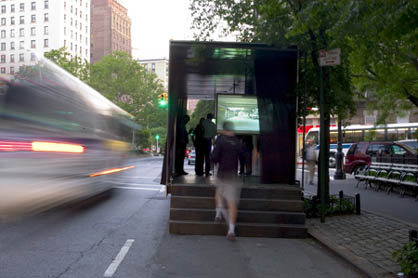 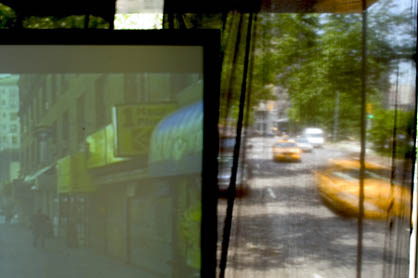 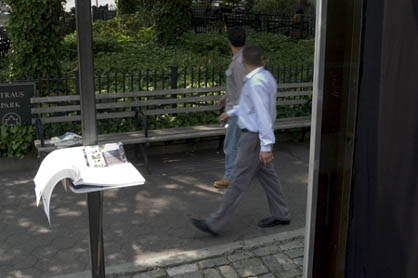 SCALE – AS DEFINED BY SPEED. As Allen Lightman writes in one of his fictional theories of time in his novel Einstein's Dreams, "And just as all things will be repeated in the future, all things now happening happened a million times before". Each interaction is the same yet it is unique. In the film Smoke, the character Auggie photographs his corner cigar store at exactly 8:00 a.m. every day. A friend flipping through the thousands of photographs remarks that they are all the same. Auggie agrees but also corrects him, pointing out that each is also completely unique. This contradiction embodies the two distinct scales that can be revealed in two different speeds. By speeding up the footage, we are able to see and understand the patterns, both physical and ephemeral, of the city - the transformations of the configuration of the street, the way the light moves through the city, the topographical changes, the movements of people and cars. Slowing down the footage, or better yet, collecting the footage -seven days entranced by what is framed within the viewfinder- allows us to become absorbed with the irreplaceable details of each take, the individual interactions that are taking place during each collected moment. These are as Sigfried Kracauer states in Theory of Film, "movements of so transitory nature that they would be imperceptible were it not for two cinematic techniques: accelerated-motion, which condenses extremely slow and, hence, unobservable developments... and slow motion, which expands movements too fast to be registered". The footage in the container was played at various time formats to allow different conditions of the city to be read. The extreme slow-motion (slowed down to occupy the length of seven days) exposed the subtleties of the everyday interactions. Slowing down revealed the gestures that usually remain unseen at normal speed. Like Bill Viola's video/sound installation, "The Greeting," - which takes the real-time, 45-second encounter of two women and stretches it into a slow-motion encounter of 10 minutes - this document is in a zoomed-in state, achieving a kind of possession of time. It is a moment so slow that it is "arrested, rendered, stretched, and compressed, in short articulated, we can state that we have possession of it, that we are approaching a new vocabulary of space-time", as stated by L. Moholy-Nagy in Vision in Motion. This extreme slowness is like a close-up in the language of the moving image and like a detail in the language of drawing. 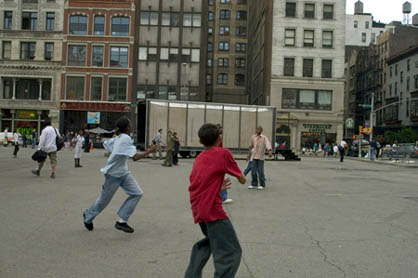 CONTAINER – A MOVING DOCUMENT. The structure of this container is divided into seven bays that define the physical structure of its construction yet also mark the seven days of the trajectory -the structure of the document- a segment of time. Plywood panels that were inserted within these bays are articulated by markings that bring light into the container while revealing information about the city - major streets that intersect Broadway from east and west as well as their location in relationship to the trajectory in time and in relationship to their topography. The section-cut (Broadway) is clearly marked as a sliver of light, an implied vertical plane defined by a gap. On it, and at certain intersections within the structure, are the three screens playing the footage at their respective speeds. 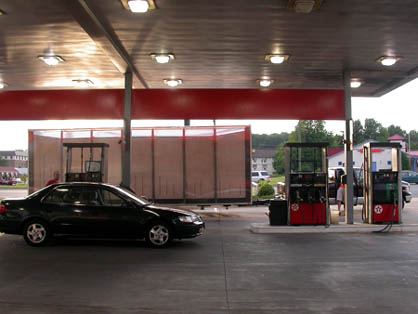 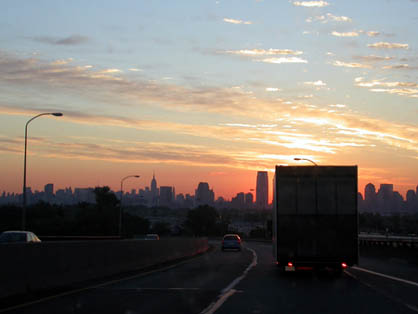 The container which was occupied by the city (its inhabitants) also occupied the city, transforming slightly or boldly the individual spaces where it rested, also marking and revealing, and engaging the activities occurring or inviting new activities, making itself evident or assimilating into the city's texture and materials. A visitor noted that "the reflections on the polycarbonate panels of the container dematerialize it and suddenly its heaviness is lifted and there it is, captured like a mysterious hologram, appearing here and there, never still!".The recent document/event in New York City which lasted a week was fleeting – it came and went, one day per site, a week on the island. It, like what it documented was ephemeral, moving and changing. Now the container sits on a lawn in South Carolina tightly wrapped in white plastic as if a cocoon of information – a time capsule again in a dormant state waiting for the next moment when it will unwrap to share and capture the city in another time, in another state. Martha Skinner, Doug Hecker |
|||
| Skinner and Hecker is a husband and wife team, co-founders of a design practice entitled fieldoffice and architecture professors at Clemson University. Their work has received various design innovation awards, including second place in the Sun Shelter Competition and Best of Category from the annual I.D. Awards. As the 1998-99 Walter B. Sanders Fellow at the University of Michigan, Skinner developed Notation A/V, a course that exploits digital audio and video recorders as tools to map both physical and ephemeral conditions of place. Skinner and Hecker who together have an interest in the relationship between the physical fixed characteristics of the city and its fleeting dynamics have received various grants to explore the visualization of these ephemeralities as a way to generate urban and architectural proposals that are sensitive to the complex interactions of a place over time. | ||||
| > FIELDOFFICE | ||||
| Per
qualsiasi comunicazione laboratorio
|